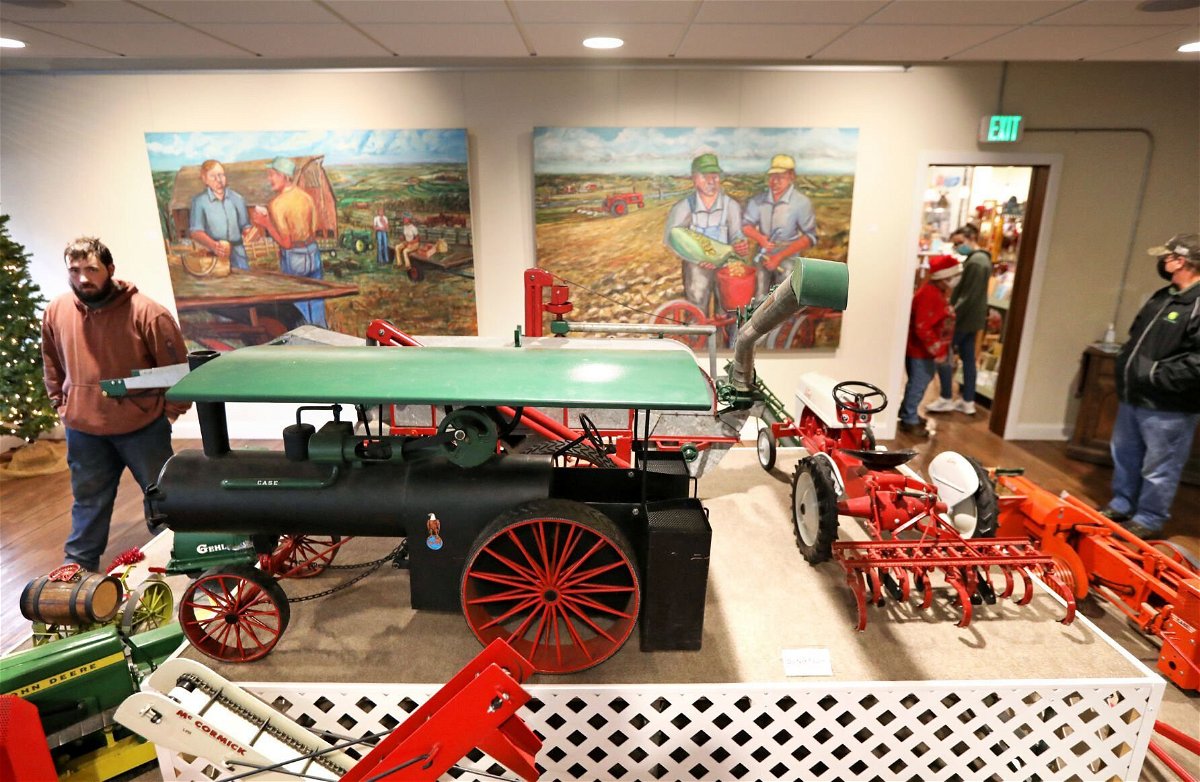Mount Horeb exhibit helps tell the story of Wisconsin agriculture

Model tractors and farm implements by Thomas Brunner
By Barry Adams
Click here for updates on this story
MOUNT HOREB, Wisconsin (madison.com/Wisconsin State Journal) — The works are in different mediums but tell a familiar story of Wisconsin’s agricultural heritage.
Douglas Eames uses oil paints and canvas. The late Tom Brunner selected metal and battery-powered motors.
And for the first time their paintings and working models of farm machinery have come together in this village’s downtown to celebrate the seasons and showcase farm life, mechanical ingenuity and passions not realized until later in life.
Eames grew up on a beef cattle farm near Mineral Point, and Brunner on a farm north of Mount Horeb near Pine Bluff. Eames, 80, began painting in his 40s, while Brunner, who died in late 2020, started building models of farm machinery when he was at a similar point in his life.
“A Country Christmas: An Artistic Tribute to American Farm Life,” at the Mount Horeb Area Historical Society’s Driftless Historium, offers up memories of the day-to-day workings of a farm and the analog machinery that was once ubiquitous on farms big and small. Only it’s all disappearing, along with the small family farms that helped mold our state into America’s Dairyland.
“We’re trying to bring together different kinds of expressions,” said Destinee Udelhoven, the historical society’s executive director since 2014, who grew up on a South Dakota dairy farm. “I think this art exhibit is important and it will resonate with people who grew up in this era and teach people who didn’t what we may be losing.”
The exhibit runs through Jan. 3 in the Kalscheur Family Foundation Community Room with hours from 10 a.m. to 4 p.m. Fridays through Mondays, but tours by appointment can be requested for Wednesdays and Thursdays. Admission is free.
The Driftless Historium, 100 S. 2nd St., is one of the gems among historical societies in Wisconsin. The $1.8 million, 14,500-square-foot museum, archive, research facility and community center opened in 2017 and includes artifacts from the now-closed Little Norway, campaign signs from former Wisconsin governor, presidential candidate and Primrose native Robert M. La Follette, and the re-creation of a rural general store. The facility, which includes a gift shop, also holds clothing, household goods, tools and nearly 25,000 photographs and thousands of documents. One of its newest exhibits is on the evolution of living rooms and includes mock-ups from the 1800s, 1930s and early 1960s.
Farm art The “Country Christmas” exhibit fits perfectly with the Historium’s mission and comes at a time when the state has only about 6,000 dairy farms compared to the more than 47,000 that were operating in 1978.
Four of the paintings by Eames are a little bit bigger than a piece of plywood but their huge size allowed the artist to focus on detail that would have been lost in smaller pieces. There are smaller paintings and a 3D aluminum piece from a wax mold in the exhibit, but Eames’ larger works can’t be ignored by visitors and provide a fitting backdrop for Brunner’s models.
One of the paintings shows farmers in the 1960s taking a break from chores as they have lunch, their table a wooden hay wagon. Another painting illustrates planting season, while two others are views from inside a farmhouse and provide a peek at the discussions that occur around a kitchen table.
“These pictures are related to what happened to me,” Eames said last week as we stood before his work he creates from memory. “That’s how I put them together, because they are a part of me.”
Eames, who has a studio in Barneveld, describes himself as a “contemporary expressionist with a regionalist theme,” but his path to oil and canvas was anything but typical while his family’s farm was among those laid waste by the farm crisis of the 1980s. Eames had also been renting farmland for himself, but after that was sold out from under him Eames transitioned to a repair and maintenance position at a farm equipment dealer.
At the same time he began sketching and drawing and was encouraged by friends to enter a UW-Extension art show intended to support cultural activity in isolated, rural areas. After winning an award at the show he took a drawing class at UW-Madison, which later led him to a degree, glass and print-making and graduate coursework at Louisiana State University.
When he first began painting, Eames would try to replicate famous paintings but now does only original work that includes abstracts. His farm scenes, however, are close to his heart.
“It helps me connect to (farming) when I paint pictures,” Eames said.
Working models Brunner was led to building working models of farm machinery after restoring a couple pedal tractors that had been used by his children. What followed was more than 30 years of taking detailed measurements, scrounging for parts and spending hours at a time in his rural Verona shop stuffed with tools and piles of metal. He would spend a year on some pieces, which included scaled replicas of machinery made by Wisconsin companies like Gehl in West Bend, Janesville Manufacturing and Fuller & Johnson Manufacturing in Madison.
In 2015, at the Greater Madison Area Farm Toy Show, he showed off a model replica of a 50-bottom plow from 1911.
Last week Brunner’s son, Paul, and grandson, Michael, were on hand at the Historium to show off a fraction of Brunner’s 200-piece collection. It includes a Case Corporation wire baler that Brunner owned but spent months recreating into a model. It’s powered by a cordless drill and can actually create miniature bales of hay.
“You have to understand how the real machine functions to understand how to make a model function,” Michael Brunner, 20, said. “That’s why grandpa would buy original (pieces) and tear them apart.”
The Historium exhibit also includes a replica of a rare, three-wheeled Gehl tractor, a horse-drawn John Deere manure spreader, a threshing machine, bulldozer, hay rake, two-row corn planter and a cultivator. Work is underway to better organize and store Brunner’s replicas at his farm, and it’s likely the machinery will again be shown at farm toy shows.
Michael Brunner, however, misses what had been constant motion by his grandfather, who never tired of building.
“It was really impressive because I’d go out into his shop and see half-built projects and he was in the middle of building stuff like this,” Brunner said, as he stood in front of a self-propelled, two-row corn picker. “I couldn’t imagine how his mind worked to build something like this. I can’t believe the way he could visualize and build something.”
Please note: This content carries a strict local market embargo. If you share the same market as the contributor of this article, you may not use it on any platform.


